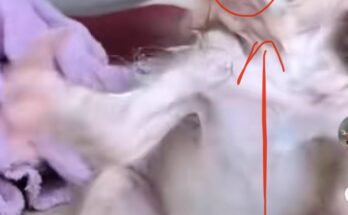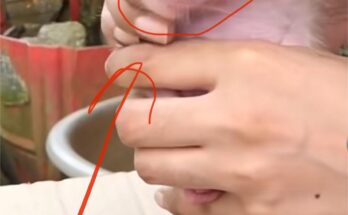In the dense heat of a remote savanna, a tragedy unfolded quietly—one that would break hearts and highlight the growing conflict between wildlife and human expansion. A baby elephant, barely a year old, found itself ensnared by barbed wire fencing meant to protect farmland from wild animals. The innocent calf, curious and unaware of the danger, became tangled, the sharp metal tearing into its tender neck as it struggled to free itself.
The image is haunting—a gentle giant in the making, trapped and trembling, its soft eyes wide with fear and confusion. This was not a scene from a nature documentary. It was a real-life emergency faced by wildlife rescue teams in many parts of Africa and Asia where human-wildlife conflict continues to rise.
Local farmers had erected barbed wire to shield their crops from elephant herds that sometimes stray into cultivated land in search of food or water. What they didn’t anticipate was the toll this would take on the youngest and most vulnerable of these creatures. The calf, separated from its herd, likely wandered through the area at dawn, lured by the scent of fresh vegetation, and walked straight into a deadly trap.
Fortunately, the story doesn’t end in tragedy. Alerted by distressed elephant calls, a group of wildlife rangers tracked the baby’s cries and arrived at the scene. What they found was harrowing. The barbed wire had deeply cut into the calf’s neck, and exhaustion had left it lying on the ground, barely moving. Every minute counted.
The team sedated the animal to minimize stress and began the delicate task of cutting away the wire. Vets worked swiftly, cleaning and disinfecting the wounds, which were dangerously close to becoming infected. After hours of tense effort, the wire was removed, and the baby elephant was stabilized. Though the physical wounds were treatable, the trauma—being alone, injured, and separated from its family—was equally pressing.
With the help of conservationists, the calf was transported to a nearby wildlife rehabilitation center. There, it will receive round-the-clock care and, eventually, if possible, be reintroduced to the wild or reunited with its herd.
This incident underscores a deeper issue: the fragile balance between conservation and human development. As farmland and infrastructure continue to encroach upon natural habitats, animals like this baby elephant are increasingly caught in the crossfire. Simple deterrents like barbed wire become lethal barriers.
What’s the solution? It lies in innovation and cooperation. Eco-friendly fencing alternatives, better land-use planning, and community education can drastically reduce these kinds of tragedies. Organizations are now working with local communities to find ways to protect both wildlife and crops without resorting to harmful barriers.
The story of this baby elephant is not just one of suffering—it’s also one of hope, compassion, and the power of human action to reverse harm. In saving one life, rescuers also sent a message: that every creature matters, and with empathy and effort, coexistence is possible.
.



